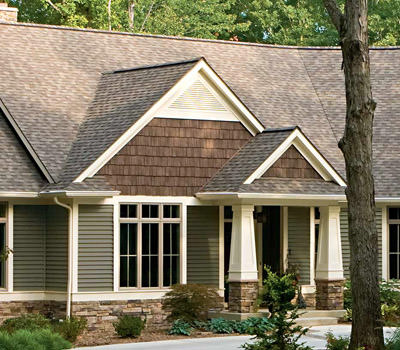Wooden shingles, stucco, aluminum siding & insulated vinyl are just a few of the many options and styles you have when you want to buy or replace siding for your home. Knowledge is power when it comes to making your final selection as replacing your siding is very pricey. It will cost the average homeowner a base price of $8,200 with costs skyrocketing up to $50,000 plus when using high-end siding such as stone.
Breaking Down the Cost
The main factors when installing new siding are materials, square footage & complexity of the home. The material you choose whether its thin vinyl or genuine stone will vastly change how much you will pay in the end.
Additional costs include changing any outside systems such as HVAC or gutters, removing old siding, cleanup, taxes, fees and license permits, as well as the soffit and fascia for the trim. This does not include the yearly or general maintenance for upkeep, painting and cleaning.
5 Types of Siding
There are lots of discussions on each on the materials you can choose for your siding. Below is a brief introduction on 5 types of siding for homes along with the pros and cons. Research your decision thoroughly before you make a decision.
Vinyl Siding
The most popular siding selected across the country is vinyl siding. According to the Survey of Construction, a whopping 32% of new homes chose vinyl siding as their choice in 2012. Vinyl is all around attractive due to its really low cost and long durability. Also there is little to no maintenance required other than power washing the siding once or twice a year. This couple with many different color options (the most of any material) makes it the #1 choice for homeowners.
The downside to vinyl is it is not waterproof and under long periods of rain or extreme weather can slowly begin to warp or deteriorate. Add to that it is made of PVC and many eco responsible homeowners tend to stay away from this material due to its toxicity.
Wood Siding
Wood siding is unmatched with its charm and beauty. Among wood you can choose from a variety of species such as pine, fur, redwood and the most popular cedar. Besides its natural and aesthetic look wood gets extra bonus points for being green and an environmentally responsible siding. Wood is also very lightweight making the labor and installation and much easier & faster.
Wood also comes with a few issues. The main beings insects, termites and other wood eating pests can greatly damage your home if it is made of wood. Proper care and treatment is necessary to prevent this. It also needs to be stained and painted every several years adding to the overall cost.
Stone Siding
If you want to make a statement then use stone siding! Natural stone siding can last forever if done properly, not to mention it can easily withstand most types of extreme weather, and offers true zero maintenance siding. However be prepared to pay top dollar for stone as this can easily surpass 10’s of thousands of dollars for an average 2,000 square foot home.
Brick Siding
Brick siding is still a popular choice amongst American homes especially in the south. This type of siding is also extremely durable and can last generations if built in the right way. Naturally fire resistant, installing brick siding can also lower your home insurance due to its permanence.
Once installed, brick siding will not be changing colors so be sure of your color and brick choice before you begin. Also it is one of the pricier options ranging from $8 – $18 per square foot installed.
Stucco
This type of siding for homes is found primarily in the west and southwest of the USA in drier and sunnier climates. Stucco siding is a unique mixture of lime, cement and sand giving it extra bonus points for the environmentally conscience. You will have not insect problems with stucco and it is also very durable lasting up to 100 years. This siding choice has its roots from Spanish exteriors.
One downside is in areas with lots of rainfall, it may not be the best choice as it is permeable. Also, cracks can easily form as the foundation of your home moves so you will have to know how to patch and repair these occurrences.
